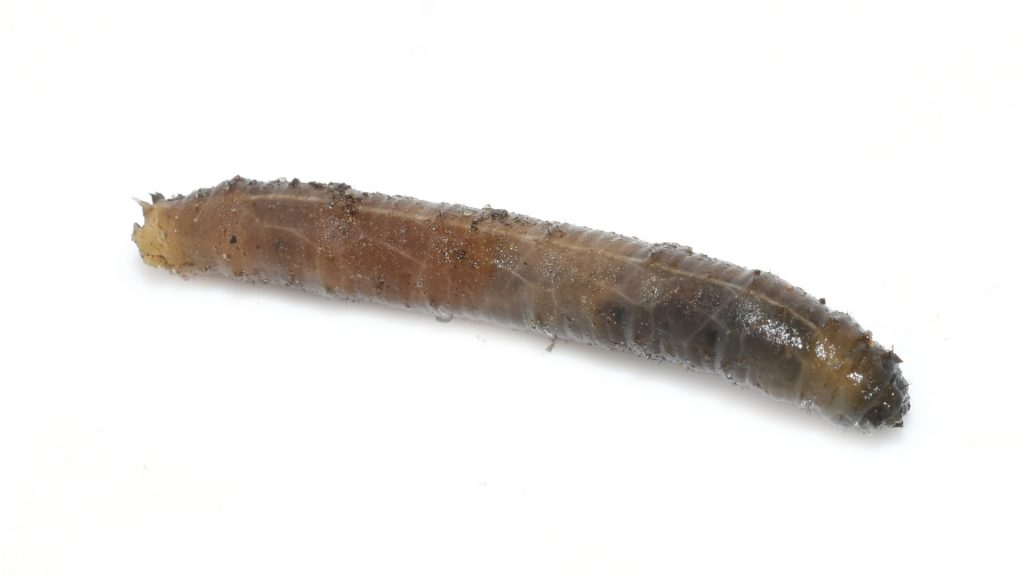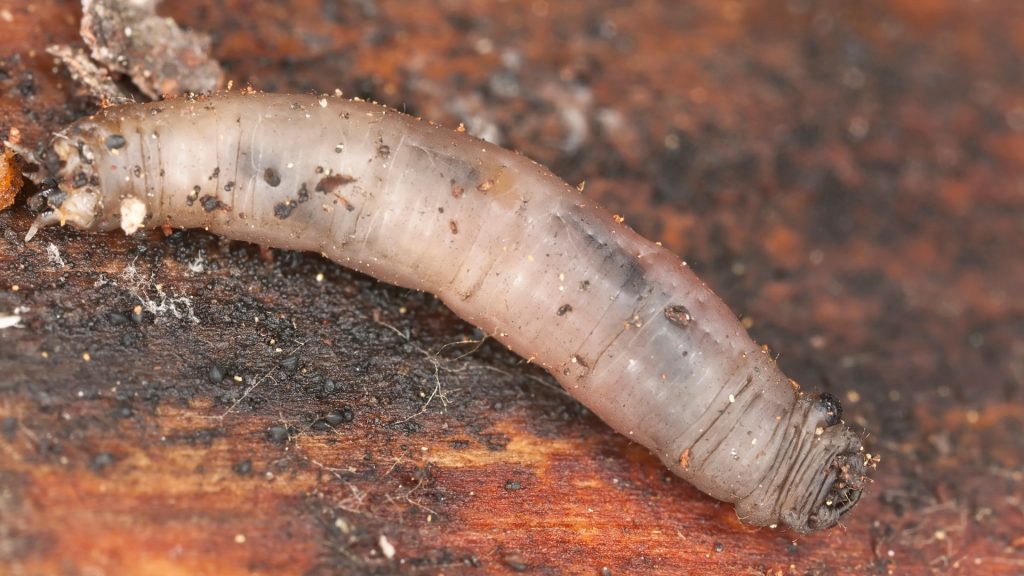Leatherjackets aren’t uncommon in many lawns. However, these insect pests are very destructive and can wreck your yard, leaving it looking bare and ugly. Are there ways to eliminate these insects, thereby protecting your beautiful lawn?
How to get rid of leatherjackets? To get rid of leatherjackets, use a nematode treatment on the entire lawn or the affected area only. Apply after it rains or water the area generously for best results. To prevent further infestation, mow your lawn often, keep it well aerated, and avoid thatch-buildup.
In this article, you’ll learn a lot about leatherjackets, including:
- What they are and how they look.
- Where they live, their life cycle, and feeding habits.
- What to use and what the best products are to get rid of them.
- How to prevent them from attacking your lawn.
What Are Leatherjacket Insects?

Leatherjacket insects are the larvae stage of crane flies or daddy long-legs. Crane flies exist worldwide, but the more diverse species are found in the tropics, northern latitudes, and areas with high elevations. They belong to the large family of insects referred to as Tipulidae.
Leatherjackets (crane fly larvae) live in various habitats. These include:
- Mud
- Leaf litter
- Rich organic earth
- Semi-aquatic environs
- Brackish, marine, or freshwater
- Moist mosses or liverworts
- Decomposing fruits
- Decaying wood or plant material and wet logs
- Dry pasturelands, steppe, and lawns
Adult crane flies lay eggs on the earth. Once the eggs hatch, leatherjackets develop with the larvae burrowing deeper into the ground during winter and returning to the surface in summer as adults. In late summer, the fully developed adult crane flies emerge from the soil in massive numbers.
How Does a Leatherjacket Look Like?
Leatherjackets have cylindrical and elongated bodies with grey, black, or brown leathery skin, while adult crane flies look like giant mosquitoes. Sporting a length of about 25 mm (0.98 in), the bodies taper towards the front with a head capsule that often retracts inside the thorax.
Their abdomen is either smooth and hairy or studded with welt-like spots or protrusions near the spiracles.
How Long Do Adult Leatherjackets Live?
Adult leatherjackets live extremely short lifespans; between 10 and 15 days at most. After hatching from the pupae, they lay their eggs within a day of hatching. Their sole goal is to mate and lay eggs, after which they die, typically within 24 hours.
Following this, the eggs laid in the ground hatch after around 2 weeks, spawning a new generation of leatherjackets. The young leatherjackets immediately start feeding on grass roots and continue throughout winter up to spring. They’re pretty sensitive to drying and cannot survive strong sunlight.
What Do Leatherjackets Eat?

Leatherjackets eat plant roots since they’re garden pests. At times, they feed on plant leaves, crowns, and the roots of crops and grasses, so they pose a huge problem for farmers. This is because they cause stunted growth, destroy crops and result in huge bald patches.
The larvae might also consume algae, other aquatic insects, microflora, and live or decaying plant matter like wood.
Still, crane fly larvae make a valuable contribution to the soil ecosystem as they process organic matter and increase bacterial activity. In addition, they’re a source of food for spiders, insects, fish, birds, amphibians, and mammals.
What Attracts Leatherjackets?
Leatherjackets are attracted to grass with shallow roots. When you overwater and overfeed your lawn, this supports shallow rooting, making your lawn appealing to leatherjackets. They feed on the easily accessible grass roots and usually stay underground during the daytime but come out at night to eat the turf leaves.
Signs of Leatherjackets in Lawn
You can spot leatherjackets on crops such as fruits, vegetables, cereals, ornamental plants, pasture, and lawn grasses. But leatherjackets’ most favorite meal is turf, and an infestation can wreck your lawn. Thus, it’s vital to avert such damage by checking your yard regularly for the larvae.
Follow the steps below to check for leatherjackets:
1. Pick a spot where grass has died out and dig some holes with a garden fork.
2. Sift through the soil using your hands to see if there are any leatherjackets.
Here’s a YouTube video showing you how to do this:
Here are some signs that the insects are present on your lawn:
- The lawn begins to wither or thin out and ultimately dies.
- Grass patches might start coming out minus their roots.
- You might see the long grey or brown larvae when you are gardening.
- You can spot the leatherjackets when the turf is wet.
- Leatherjackets could start appearing on adjoining paths during damp weather.
- You’ll notice birds pecking at the soil (during winter) or your grass (in the summer).
- Large predators may dig up the leatherjackets from your lawn leading to more intensive damage.
It’s important to note that since leatherjackets are black or brown, it might be challenging to see them at times. As such, you might only notice their presence on your lawn and after they cause damage.
How To Get Rid of Leatherjackets in Your Lawn?

The best time to control crane flies is during the larvae stage. It’s also better to use organic rather than chemical leatherjacket treatments.
To get rid of leatherjackets in your lawn, try the following:
Use a Nematode Treatment
Apply a nematode treatment to the affected areas after a downpour or wet the area using a sprinkler. This natural method of eliminating leatherjackets entails using nematodes, which are microscopic worms found in lawns and gardens. Certain species of nematodes feed on leatherjackets; hence adding to their numbers will ensure that they kill all of them.
This eco-friendly method is effective as it kills the leatherjackets within weeks. It’s also safe to use if you have children or pets. However, the age of the leatherjackets, soil moisture levels, and timing are all critical factors in a successful nematode treatment.
Cover Your Lawn With Black Plastic Sheet
To get rid of leatherjackets before they cause excessive damage, try covering the entire lawn with a black plastic sheet throughout the night. You can also cover only the affected area. Doing so encourages the leatherjackets to emerge to the surface, where you can then brush them off and destroy them.
Use Natural Predators
Starlings are small birds that are natural predators of crane flies and leatherjackets. What’s more, their narrow beaks allow them to feed on the pests with minimal damage to your turf. You can use something like this Wendt & Kuhn Starling Box to support their nesting, and they’ll help reduce the leatherjackets in your yard.
Additionally, you can try the following:
- Fork the soil to expose the leatherjackets to the birds – they’ll consume them.
- Reseed or replace your lawn if the infestation is severe.
What To Use To Get Rid of Leatherjackets? Products Review
Here are some products from Amazon that you can use to get rid of leatherjackets:
Bio Advanced Complete Insect Killer
This formulation kills grubs and leatherjackets, delivers season-long protection, and also promotes fresh growth, a thicker turf, and stronger roots. By forming a protective zone around your lawn, it eliminates the leatherjackets before they get the chance to destroy your turf, helping it retain its beauty. To apply it, use a rotary spreader at the recommended rate, then water your lawn thoroughly.
Scotts Grub Killer
- Scotts GrubEx1 Season Long Grub Killer can help prevent turf...
- One application of this lawn care treatment kills and prevents...
- This grub killer also controls caterpillars (armyworm),...
- Apply this granular insecticide to a dry lawn in the spring or...
- One 28.7 lb. bag of Scotts GrubEx1 Season Long Grub Killer covers...
This product helps keep your lawn healthy and strong by getting rid of leatherjackets that cause root damage. A single application during spring or early summer kills and prevents the insects from attacking your lawn for up to 4 months. It’s quite effective against young larvae that cause the most damage and is easy to apply using Scotts spreaders.
Use Scotts Grub Killer on a dry lawn, then water generously to activate.
Lawnbox Organic Grub Control
- 100% organic biological insecticide used to control grubs –...
- Helps prevent lawn damage caused by grubs and animals looking to...
- Controlling grubs also helps to control the population of...
- Non-toxic to insects, pollinators and birds
- Family friendly - yard is safe to use immediately after applying
This 100% organic biological insecticide is excellent to use in controlling leatherjackets. It doesn’t only help prevent leatherjackets from damaging your lawn, but it also helps you avoid damage caused by animals that prey on leatherjackets. This product is also not toxic to birds or insects, and you can use the lawn immediately after application.
Roundup Bug Destroyer
- Kills 100+ listed insects by contact and keeps on killing for up...
- Kills insects above and below the lawn's surface, including ants,...
- For residential lawns, landscaped areas, and ornamental and...
- Kills grubs
- Won't harm lawns
Roundup Bug Destroyer kills insects both below the lawn’s surface and above. A single application is effective for up to 3 months, killing all the young leatherjackets before they destroy your lawn.
Also, the product comes with an easy-to-use spreader and causes no harm to your yard. Avoid infestations by applying the treatment in spring and then water the area.
How To Prevent Leatherjackets?
To prevent leatherjackets from invading your lawn, you can do the following:
- Scarify the lawn to eliminate thatch-buildup and make it a less favorable nesting ground for the leatherjackets.
- Aerate the lawn and ensure to keep it well-drained.
- Keep your yard neat and trim.
- Take the necessary precautions if you notice heightened crane fly activity during summer, such as applying nematodes.
Summary
Having leatherjackets on your lawn is normal as they’re part of the natural ecosystem. However, an infestation can ruin your turf, so you need to take precautionary measures if you notice leatherjacket activity increasing, especially towards late summer.
Follow the simple tips outlined in this article to save your yard and protect you from the expense of replacing the lawn altogether.
Related: Crane Fly vs. Mosquito: Main Differences, Identification, and Biology
List of Sources
Agriculture and Natural Resources. (2017). How to Manage Pests, The UC Guide to Healthy Lawns: Beneficial nematodes. University of California.
U.S. Fish & Wildlife Service. (2001). European Crane Fly Control and Lawn Care.
Baker, J. (2020). Leatherjackets and Crane Flies. NC State Extension Publications.
Peck, D. C. (2006). European crane fly. Cornell University.
- How to Get Rid of Turtles | Proven Long-Term Solutions! - August 26, 2023
- How to Get Rid of Kingsnakes | Easy & Humane! - August 26, 2023
- How to Get Rid of Northern Water Snakes | Best Solutions and Preventative Measures! - August 19, 2023





